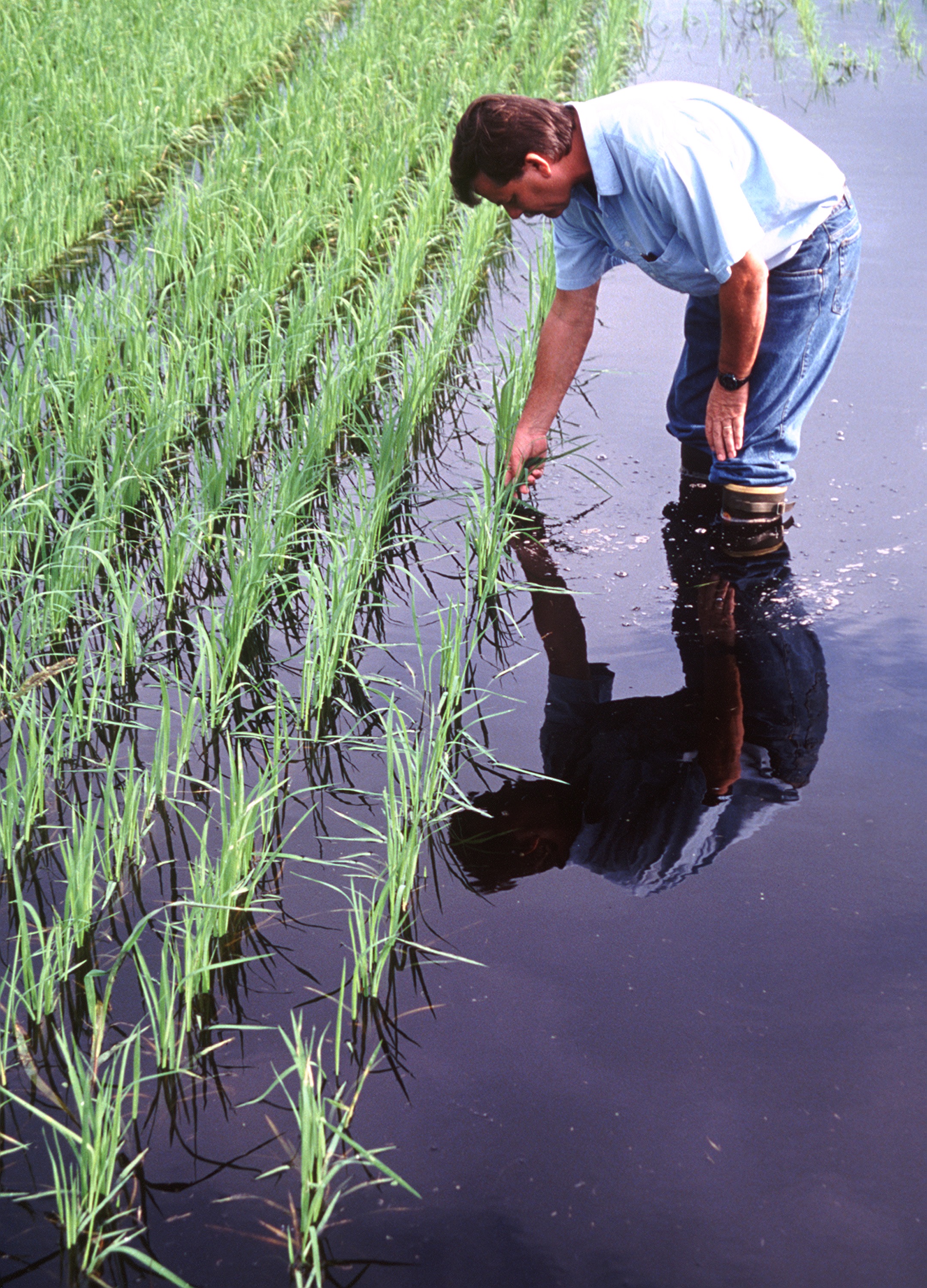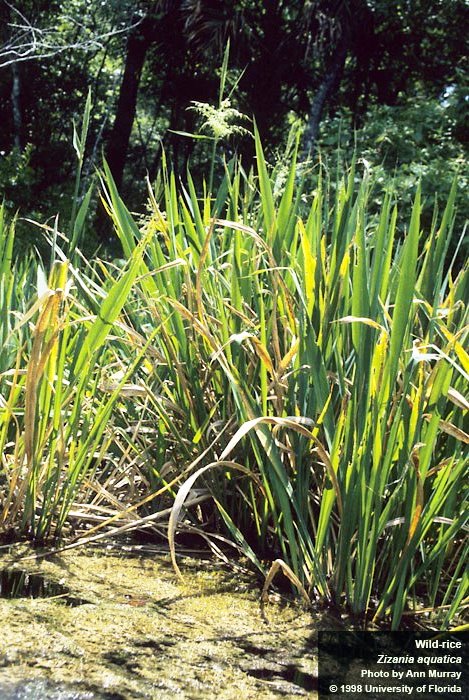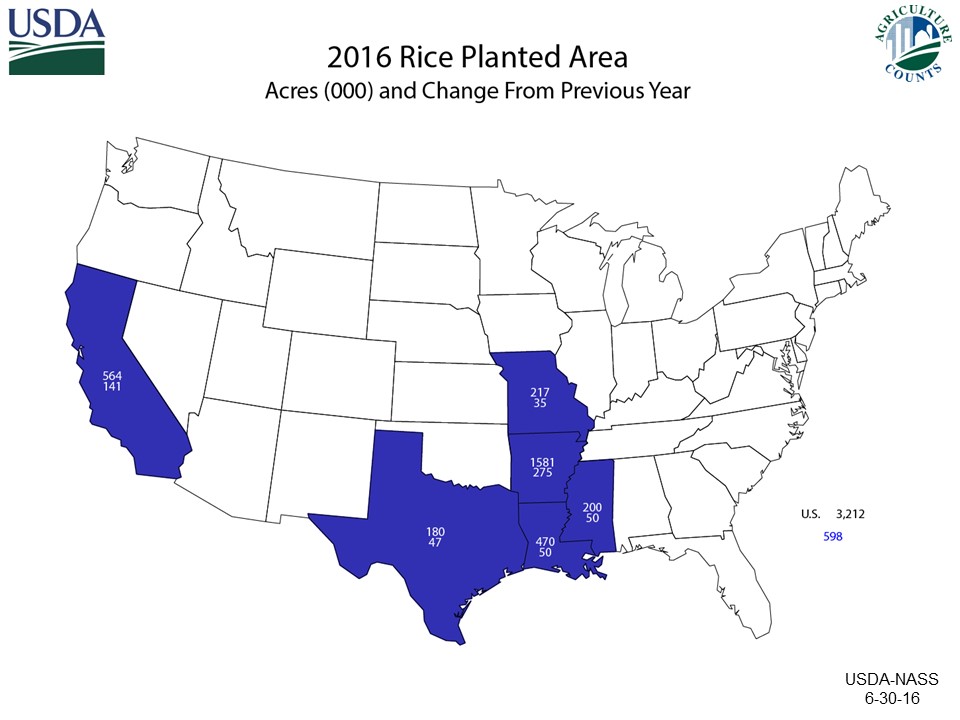
Figure 1. Rice growing in the flooded fields of Florida’s Everglades Agricultural Area. Photo Courtesy of UF/IFAS File Photo Collection
On a recent trip to Arkansas, I was captivated by the beauty of vast fields of flooded rice nearly ready for harvest. That image is just something you don’t see every day in the Florida Panhandle! Equally interesting is the fact that rice is a semi-aquatic plant, related to wild rice “cousins” which grow natively right here in Florida waters (Figure 2). So, I decided to learn more about how rice grows, and if there is a rice crop in Florida. Turns out rice is indeed grown in Florida, the acres of which are beginning to increase (Figure 1.)

Figure 2. Wild rice (Zizania aquatica) growing in Florida. Note the seed head at the top center of the photo. Photo courtesy of UF/IFAS File Photo Collection.
Florida Rice Production:
According to the publication, Trends in Rice Production and Varieties in the Everglades Agricultural Area (EAA), rice has been grown in the wetlands of south Florida for over 60 years. Part of that history included a protective quarantine on production in the late 1950s, due to a rice disease discovered in South America. Rice was reintroduced as a south Florida crop in 1977, grown as a cover crop during the fallow period of the sugarcane production cycle.
During the summer period, more than 50,000 ac of fallow sugarcane land is available for rice production. In 2015, approximately 23,000 ac of rice were planted in the EAA (Florida Rice Council 2015). The net value of growing rice in the EAA as a rotation crop far exceeds its monetary return. In addition to being a food crop in Florida, production of flooded rice provides several benefits to the agroecosystem. By flooding fields, growers greatly reduce the negative impacts from issues related to soil subsidence (Wright and Snyder 2009), nutrient depletion, and insect pests (Cherry et al. 2015). This, in turn, enhances the subsequent sugarcane crop and maximizes the longevity of the soil by reducing soil loss due to oxidation. Trends in Rice Production and Varieties in the Everglades Agricultural Area
The acres of rice grown in south Florida have increased since 2008. Most of the rice acreage is produced by the Florida Crystals Corporation (FCC). This company primarily grows sugarcane, but incorporates rice during fallow periods. Other rice producers include local farmers that grow sugarcane and winter vegetables. According to the above referenced publication, 22,861 acres of rice were planted in 2015. Of the 22,861 acres, local growers planted 6,564 acres, and FCC planted 16,297 acres.
Rice Production:
Discovery of ancient fields in China dates the beginnings of rice cultivation to more than 6,000 years ago. Now rice is grown all over the world, and is a critically important food crop for many countries. Over 90 percent of the world’s rice is produced and consumed in the Asia-Pacific Region, and in terms of production, rice is one of the top 3 grains grown and harvested in the world. The USDA Foreign Agricultural Service reports nearly 500 million metric tons are produced each year in the world, and according to the USDA Economic Research Service, U.S. citizens consume over 100 million pounds of rice each year.
Most of the rice in the United States is grown in six states. As shown in Figure 3, Arkansas leads the nation’s rice production with over 1.5 million acres planted in 2016. Other major rice producing states are, in order of 2016 acres planted, California, Louisiana, Missouri, Mississippi, and Texas.
Rice Cultivation:
Because rice is a semi-aquatic plant, production is unique among agricultural crops as it includes periods where the fields are flooded. Flooding rice fields aid in the management of weeds and pest insects. While rice is adapted to growing in water, many weeds are not, and the flooded fields reduce germination of these weed seeds. The timing, duration, and frequency of floods depends on a number of factors including planting method, time of year, seedling emergence, soil type, field size, and how level the field is. Land preparation for planting rice begins in late winter. In Florida’s fallow sugarcane fields, rice planting usually begins during spring and continues into early summer. The process of incorporating the flooding cycles into the rice fields usually begins in early summer when rice reaches a certain growth stage. Rice is harvested in late summer through early fall using combines that cut the stalks and thresh the grains from the seed heads. The grain is then dried to optimum moisture levels for storage, transport, and packaging.
Summary:
Rice is a globally critical crop that feeds people on nearly every continent. While the scale of rice grown in Florida is relatively insignificant, when compared to the rest of the United States, the inherent growth characteristics and cultivation methods provide important secondary benefits to both the environment and sugarcane fields of the Florida Everglades Agricultural Area. These values include improved pest management, water conservation, habitat for wildlife, improved fertilizer efficiency, and increased organic amendments from rice stubble. The short video above by Florida Crystals Corporation highlights the unique attributes of growing rice in Florida.
For more information on rice, please see the following resources used for this article:
-
Trends in Rice Production and Varieties in the Everglades Agricultural Area
-
Weed Management in Rice
-
Rice in the Crop Rotation
-
University of Arkansas – Rice Production in Arkansas
-
University of Arkansas – Arkansas Rice Production Handbook
-
The USDA Foreign Agricultural Service
-
The USDA National Agricultural Statistics Service – Rice
-
USDA Economic Research Service – Rice
-
The Food and Agriculture Organization of the United Nations: Rice Production in the Asia-Pacific Region: Issues and Perspectives
-
National Geographic News- Stone Age Rice Fields Discovered in China Swamp
- Maintaining Dissolved Oxygen Levels in Your Pond to Reduce Fish Kills - September 21, 2018
- The Bumble Bee – One of Florida’s Vital Pollinators - September 14, 2018
- 2017-2018 Bee Informed Partnership’s National Bee Colony Loss Report - July 13, 2018

